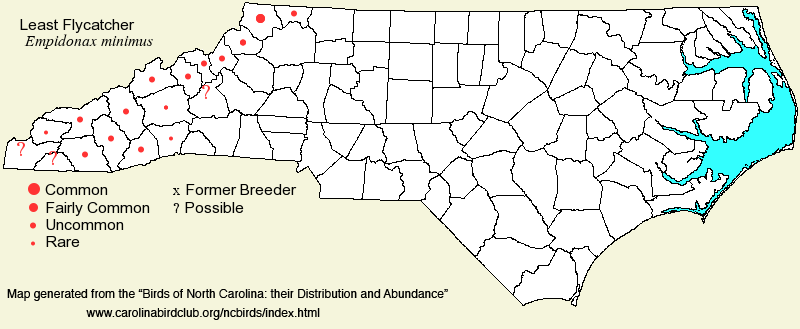 |  |
|
Least Flycatcher - Empidonax minimus TYRANNIDAE Members: | Search Common: Search Scientific: |
|
|
|||||||
| General Comments | The Least Flycatcher, as its name implies, is the smallest species of flycatcher in the Eastern Unites States, though it is not the smallest in the country (i.e., Northern Beardless Tyrannulet). Unlike with the Willow and Alder flycatchers, which were not known to nest in the state prior to 1950, the Least has always been known to nest in the state, and its somewhat spotty range in the mountains seems to have remained steady over many decades. As with those others, its migratory status in the Piedmont and Coastal Plain is not well known because of plumage and call similarities to one or more Empidonax species. On its breeding grounds, it favors mature hardwood groves in semi-open country, such as farmyard trees, rows of trees along a river amid fields, and even at golf courses; it does nest in mature, medium-growth hardwood forests, but usually along and near edges. However, such micro-habitats are abundant in the mountains, yet the birds are localized, often with a few pairs clustered in a small area, and with portions of entire counties seemingly devoid of the species. Middle elevations -- 3,000 to 4,500 feet -- are preferred. | ||||||
| Breeding Status | Breeder | ||||||
| NC BRC List | Definitive | ||||||
| State Status | W | ||||||
| U.S. Status | |||||||
| State Rank | S3B | ||||||
| Global Rank | G5 | ||||||
| Coastal Plain | Transient. Rare along and very close to the coast, but seemingly casual to very rare farther inland (only about four such reports). This pattern, as well as that for Willow and Alder flycatchers, suggests that the species essentially avoids the Coastal Plain in spring and fall migration, and that records close to the coast are of birds blown off course and forced to land when reaching large bodies of water. Mainly late Apr to late May, and late Aug to mid-Oct. One was photographed and recorded calling at Alligator River NWR (Dare) on the very late dates of 21-27 Nov 2020. There are two reports from CBC's: one on the Mattamuskeet count on 28 Dec 1986, and one on the Cape Hatteras count on 29 Dec 2000. Though these reports were made by experienced birders, one wonders if species of the Western United States, such as Dusky Flycatcher, could be completely ruled out. However, one photographed and more importantly audio-recorded at Duck Park (Dare) from 13-24 Jan 2022 seems quite conclusive. Peak counts: 2, on two occasions. | ||||||
| Piedmont | Transient. Rare in spring, and rare to uncommon in fall, across the region; most records are for the eastern part of the region, but this has to be an artifact of field work (as the bulk of the species' range is to the west of the Piedmont). Mainly late Apr to late May, with a few Jun records (a bird on territory at Tryon in 1987-88); late Aug to early Oct. Peak counts: 2, on several dates. Note that many of the Leasts that pass through the region, especially in fall, will be silent or will only give the "wit" call, which is very similar to that of the Willow Flycatcher; thus, many or most will likely not be conclusively reported by observers. | ||||||
| Mountains | Summer resident. Very local, generally uncommon as a whole, but locally fairly common, and rare to absent in other seemingly suitable habitats and elevations. Apparently not yet known in the breeding season from the extreme southwestern tip of the province (Cherokee and Clay). Also not found along and within a few miles of the Blue Ridge Escarpment as a breeder. Mainly late Apr to late Sep. Peak counts: 36, Great Balsam and Plott Balsam Mountains IBA spring count, 18 May 2013. | ||||||
| Finding Tips |
Good areas during the nesting season include the Highlands Country Club (Macon), Black Camp Gap (Great Smoky Mountains NP), and along roads adjacent to the New River and the South Fork New River (Ashe). However, routine driving of back roads for a day in the mountains might well fail to find the species in the breeding season. ** to *** | ||||||
| Attribution | LeGrand[2025-02-03], LeGrand[2023-03-24], LeGrand[2022-04-27] | ||||||
| NC Map Map depicts all counties with a report (transient or resident) for the species. | Click on county for list of all known species. |
| NC Breeding Season Map Map depicts assumed breeding season abundance for the species. |  |